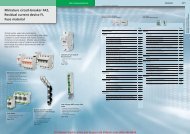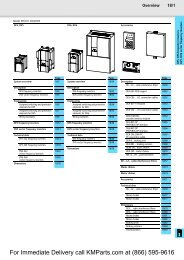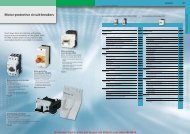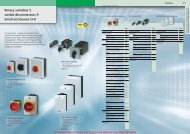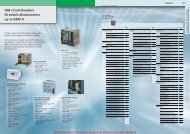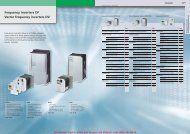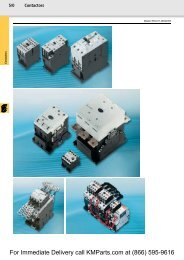Circuit-breakers NZM1, 2, 3, 4 up to 2000 A - Moeller Electric Parts
Circuit-breakers NZM1, 2, 3, 4 up to 2000 A - Moeller Electric Parts
Circuit-breakers NZM1, 2, 3, 4 up to 2000 A - Moeller Electric Parts
Create successful ePaper yourself
Turn your PDF publications into a flip-book with our unique Google optimized e-Paper software.
10/108<br />
Engineering<br />
MCB, back-<strong>up</strong> protection<br />
<strong>Circuit</strong>-<strong>breakers</strong>, switch-disconnec<strong>to</strong>rs<br />
<strong>NZM1</strong>, NZM2, NZM3<br />
Protection of PVC insulated cables against thermal overload with short-circuits<br />
According <strong>to</strong> VDE 0100 part 430 cables and<br />
conduc<strong>to</strong>rs must be protected against short-circuit<br />
and overload. The overload protection is obtained by<br />
using NZM circuit-<strong>breakers</strong> with settable, currentdependent,<br />
delayed overload release.<br />
Short-circuit protection is provided by adjustable<br />
instantaneous releases, which open the main contacts<br />
in less than 25 ms. The short-circuit <strong>to</strong>tal opening<br />
time restricts the temperature rise of the cable <strong>to</strong> a<br />
minimum.<br />
Min. protected cross-section mm 2 copper<br />
NZM...1(-4)-...20 6<br />
NZM...1(-4)-...25 … 160 10<br />
NZM...2(-4)-...20 … 250 10<br />
NZM...3(-4)-...250 … 630 16<br />
NZM...4(-4)-...630 … 1600 95<br />
<strong>Moeller</strong> HPL0211-2007/2008<br />
http://catalog.moeller.net<br />
The tables indicate the minimum conduc<strong>to</strong>r crosssection<br />
reliably protected by circuit-<strong>breakers</strong> during a<br />
short-circuit. (Operating voltage U N = 415 V)<br />
Back-<strong>up</strong> protection<br />
between NZM(N)(H) incoming circuit-breaker and NZMB(N)(H) outgoing circuit-breaker<br />
Incoming circuit-breaker a<br />
<strong>NZM1</strong> NZM2 NZM3<br />
I n <strong>up</strong> <strong>to</strong> 160 A <strong>up</strong> <strong>to</strong> 250 A <strong>up</strong> <strong>to</strong> 630 A<br />
a<br />
I cu(415 V) 25 kA 36 kA 50 kA 100 kA 25 kA 36 kA 50 kA 150 kA 50 kA 150 kA<br />
Outgoing circuit-breaker b<br />
I cu(415 V) I n<br />
NZMB1 25 kA <strong>up</strong> <strong>to</strong> 160 A 25 36 50 100 25 36 50 100 50 100<br />
NZMC1 36 kA <strong>up</strong> <strong>to</strong> 160 A – 36 50 100 36 50 100 50 100<br />
b NZMN1 50 kA <strong>up</strong> <strong>to</strong> 160 A – – 50 100 – – 50 100 50 100<br />
NZMH1 100 kA <strong>up</strong> <strong>to</strong> 160 A – – – 100 – – – 100 – 100<br />
NZMB2 25 kA <strong>up</strong> <strong>to</strong> 250 A 25 36 50 100 25 36 50 150 50 150<br />
NZMC2 36 kA <strong>up</strong> <strong>to</strong> 250 A – 36 50 100 – 36 50 150 50 150<br />
NZMN2 50 kA <strong>up</strong> <strong>to</strong> 250 A – – 50 100 – – 50 150 50 150<br />
NZMH2 150 kA <strong>up</strong> <strong>to</strong> 250 A – – – – – – – 150 – 150<br />
NZMN3 50 kA <strong>up</strong> <strong>to</strong> 630 A – – – – – – – – 50 150<br />
NZMH3 150 kA <strong>up</strong> <strong>to</strong> 630 A – – – – – – – – – 150<br />
Where the prospective fault current at the point of<br />
installation of circuit-<strong>breakers</strong> is very high, it is<br />
conventional <strong>to</strong> use NZMN(H) current-limiting circuit<strong>breakers</strong>.<br />
An attractively priced alternative is <strong>to</strong> fit a<br />
NZMN(H) current-limiting circuit-breaker <strong>up</strong>stream of<br />
NZMB(C)(N) standard circuit-<strong>breakers</strong>, if the fault level<br />
is <strong>to</strong>o high for NZMB(C)(N) switches.<br />
The table shows which current-limiting circuit-breaker<br />
NZMN(H) in combination with NZMB(C)(N) are <strong>to</strong> be<br />
used <strong>to</strong> provide protection at the network locations<br />
with high short-circuit capacities.<br />
The selectivity limit is determined by the response<br />
current of the non-delayed short-circuit release in the<br />
<strong>up</strong>stream incoming circuit-breaker. In many<br />
applications this is sufficient.<br />
between NZM...1-A... incoming circuit-breaker and FAZ-B(C)/PLSM-B(C)... outgoing circuit-breaker<br />
Outgoing circuitbreaker<br />
NZM(B)(C)2-A... NZMC(N)(H)1-A...<br />
Outgoing circuit-breaker<br />
I cc<br />
FAZ-B(C)...<br />
0,5 – 16 25 kA 30 kA<br />
NZM...<br />
20 – 40 20 kA 20 kA<br />
50, 63 15 kA 15 kA<br />
PLSM-B(C)...(/...)<br />
PLSM<br />
0,5 – 16 25 kA 30 kA<br />
20 – 40 20 kA 20 kA<br />
50, 63 15 kA 15 kA<br />
between NZM...2-A... incoming circuit-breaker and FAZ-B(C)/PLSM-B(C)... outgoing circuit-breaker<br />
Outgoing circuitbreaker<br />
NZMB(C)2-A...<br />
NZMN(H)2-A...<br />
Incoming circuit-breaker<br />
I cc<br />
FAZ-B(C)...<br />
0,5 – 10 25 kA 50 kA<br />
NZM...<br />
13 – 32 25 kA 30 kA<br />
40 – 63 20 kA 20 kA<br />
PLSM-B(C)...(/...)<br />
PLSM<br />
0,5 – 10 25 kA 50 kA<br />
13 – 32 25 kA 30 kA<br />
40 – 63 20 kA 20 kA<br />
For <strong>Moeller</strong> <strong>Electric</strong> Sales and S<strong>up</strong>port call KMparts.com (866) 595-9616



